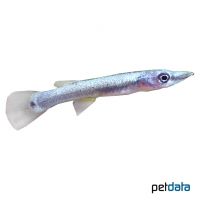Pike Killifish (Belonesox belizanus)
| Pike Killifish Belonesox belizanus | |
|---|---|
| Name | Pike Killifish |
| Name Lat. | Belonesox belizanus |
| Family | Livebearers |
| Family lat. | Poeciliidae |
| Order | Killifishes & Livebearers |
| Order lat. | Cyprinodontiformes |
| Origin | Central America |
| Habitat | Coastal waters |
| Diet | Carnivore |
| pH | 7.5-8.2 |
| Behavior | Predatory |
| Keeping | Pair, group |
| Care Level | Moderate |
| Reproduction | Livebearer |
| Breeding | Simple |
| Life Span | 3-5 years |
| Protection | No |
| Metric Units | |
| Size | 15-20 cm |
| Temperature | 23-29 °C |
| Hardness | 20-35 °dH |
| Aquarium | 100 cm / 200 l |
| US Units | |
| Size | 5.9"-7.9" |
| Temperature | 73-84 °F |
| Hardness | 356-623 ppm |
| Aquarium | 50 gal |
Distribution and habitat
The range of the pike carps is on the Atlantic coast of the Americas and extends from southern Mexico to Nicaragua, where they are found in fresh and brackish water. They live in the clear waters of slow-moving or stagnant waters with dense underwater vegetation.
Maintenance
The aquarium should have a partly dense edge planting, with shelters and hiding places (roots) and provide sufficient swimming space. A dark substrate, some shaded light (floating plants) and slightly alkaline, medium to hard water is ideal.
No ammonia, ammonium and nitrite should be detectable, the nitrate value should not exceed 100 mg/l. To ensure the water quality and oxygen content, a filter and heater adapted to the aquarium size is required, as well as lighting for the species-appropriate day-night rhythm of the animals.
Diet
They are bumper predators that lurk hidden among plants for prey. In nature they feed mainly on fish. According to their size, the food supply consists of live food, such as cyclops, daphnia, artemia, mosquito larvae, etc., which is often also accepted frozen. Larger animals can only be fed with live fish in the long run (approx. one guppy per day).
Regular and varied feeding promotes health and increases resistance.
Behaviour and compatibility
These shy fish should be kept in pairs or better in a group where the number of females predominates. They can be well socialized only with large, robust fish. However, it is better to keep them in a species tank. Fish that are too small are considered food.
Basically, only compatible fish species with similar requirements for water condition and water temperature should be socialized.
Sex dimorphism
The much smaller, max. 12 cm large males are more colorful and have an anal fin (gonopodium) transformed into a mating organ. The up to 20 cm large females have a yellow to orange anal fin base.
Reproduction and breeding
They are live-bearing fish. Internal fertilization is provided by the male's gonopodium. After about 6-8 weeks of gestation, up to 100 fry are born. The fry, 2-3 cm in size at birth, are already fully developed and independent. They are defended by the mother, which has a feeding block after birth.
Fry must be fed several times a day with special rearing food (Artemia nauplii, dust food). In community tanks breeding is hardly possible, because the fry are easy prey.
Important
Soft water is not tolerated well on a permanent basis, so the addition of sea salt (mineral salt) from the pet store to harden the water is recommended for soft water.
The well-being of the fish should be checked regularly. The temperature should be checked daily, the pH, hardness and nitrate value at least every 14 days. Regular partial water changes are recommended, even if the contaminant level has not yet reached the upper limit. Sudden changes in water quality should be avoided. Newly introduced fish must be accustomed slowly to the water in the aquarium
Further literature can be found in your pet store.
References
Text: petdata; Image: petdata
Source: BMELV (1998): Tierschutzgutachten - Haltung von Zierfischen (Süßwasser); BAENSCH & RIEHL (2006): Aquarien Atlas Bd. 4, Mergus Verlag; ENGELMANN (2005): Zootierhaltung - Tiere in menschlicher Obhut: Fische, Verlag Harri Deutsch
- Gemäß § 21 Abs. 5 Tierschutzgesetz idgF
